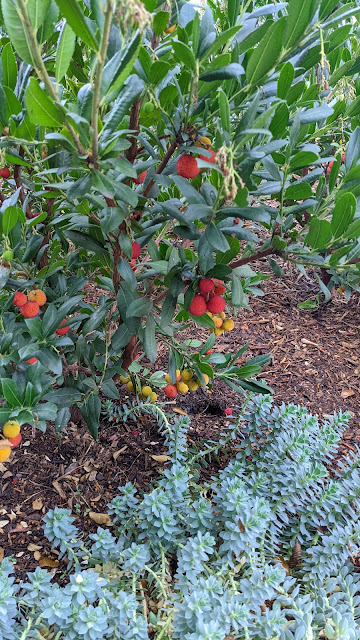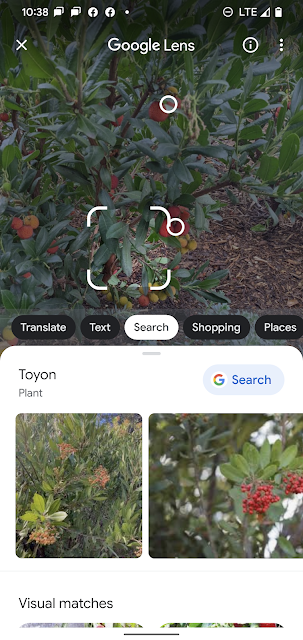Searching by image...
 |
| What plant is this? Can search-by-image help? |
... is a fundamental skill for SearchResearchers. You should know how to use regular Google Search-by-Image (see this for a refresher), and you should know how to use Google Lens (refresher), and you should know about Bing's Search-by-Image, Tineye, and Yandex's search-by-image tool as well. That's five major search-by-image systems that you should just know how to use.
But the problem with all of these systems is that they do what they can with what they see, but you shouldn't rely on them for proper identification, particularly of plants, dogs, cats, people, and the random marginalia of life.
Here's what I mean.
This is a photo I took of a plant growing in a nice Silicon Valley bit of landscaping. I happen to know what this is. (It's an Arbutus unedo, which we've talked about before in SRS, post about these plants back in 2014.) I'm curious to see if Google Lens will identify it correctly or not. I know this is a difficult search because this plant looks superficially like several others. Here, I'm interested in the plant with the red berries and not the low-growing plant below it.
 |
| Original Photo |
As you know, you can select the region of interest in the photo--basically telling the image reco system what to pay attention to, so I first selected a random bit of leaves, branches, and a corner of one of the fruits. This turns out not to have worked well at all.
Arbutus unedo, an evergreen shrub or small tree in the family Ericaceae native to the Mediterranean region and western Europe. The plant is known for its fruit which look a great deal like a strawberry, hence the common name "strawberry tree." However, it is not really related to strawberries at all.
SearchResearch Lesson about Search-by-image
1. Basically, you have to be careful and check your results. It's tempting to do a quick search and be done with it, but if you're trying to figure out if it's a potentially deadly flower (or berry, or insect bite...), you'll want to do as you always do and DOUBLE CHECK.
Note that all of the search-by-image systems (Tineye, Yandex, Bing, Google, etc.) are all sensitive to the are of interest--you will get different answers depending on which region of the image you ask about.
None of them will tell you about the degree of certainty, but will give you a ranked list, rank ordered by a mysterious relevance operation that probably has nothing to do with accuracy, but more to do with image similarity.
And it should go without saying, but NEVER TRUST a search-by-image function to identify a mushroom. To get a complete ID of a mushroom often requires examining the gills and the spores, frequently with a microscope.
Be aware of the limits of the tools you use--the skilled SRS Researcher knows the limits!
2. The guidance you give to the algorithm is really important. Try to select an area of the image that has all of the information you would need to do an identification. In this case, that would be leaves + fruit + branches. Or, if you're trying to identify something non-botantical, try to find the "most representative" piece of the image, and not just a random decontextualized fragment.
Search on! (Cautiously...)



Hi Dr. Russell.
ReplyDeleteOnce again, very interesting and helpful. Being there, done that. I have searched sometimes and found some possible answers.
In some cases I was sure the answer was right. In others, kept the results and tried to verify in other way. And sometimes, didn't find a good answer.
What is interesting to me, is that Search by image and Google Lens many times give different answers. I searched by image your photo and strawberry is one of the answers.
That is why I try with both tools as a confirmation method
non-mobile - had the best luck with Yandex… deserves a toast
ReplyDeleteplants one can imbibe…
now that we know what it is, this may explain why it is planted in the valley?
a testimonial
more recent
related
in a jam
Fascinating! I had no idea that there was a liqueur made of the strawberry fruit. Thanks for the links. I HAVE tasted the fruit, and the taste is fine... but the fruit itself has a somewhat disagreeable mealy texture. I assume one filters all of this out leaving just the great taste. Nice find.
Delete"(in Italian)
DeleteO verde albero italico, il tuo maggio
è nella bruma: s'anche tutto muora,
tu il giovanile gonfalon selvaggio
spieghi alla bora
— Giovanni Pascoli
Oh green Italian tree, your May month
is in the mist: if everything die,
you, the youthful wild banner
unfold to the northern wind"
from wiki, hmmmm, the honey from the blossom is a bitter delicacy
a Victorian crumble cake
checked the 'talkies'…
shorter
smoothie
cropped to find the city in this searching image — worked well — Montréal, wouldn't have guessed that
ReplyDeleteBritannica confirmed
Hochelaga Archipelago